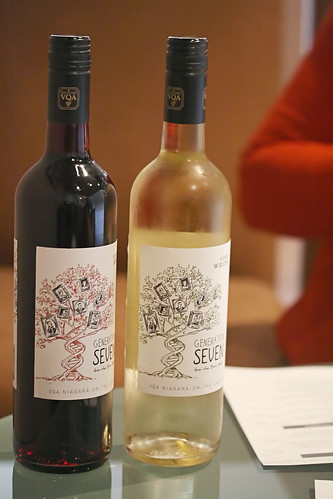 I'm ever so pleased to be contributing to the kick off of Kitchen Play, a new concept assembled by Casey at Tastestopping that allows bloggers to connect with sponsors to create a unique Progressive Dinner featuring their products.
I'm ever so pleased to be contributing to the kick off of Kitchen Play, a new concept assembled by Casey at Tastestopping that allows bloggers to connect with sponsors to create a unique Progressive Dinner featuring their products.
When Casey got in touch with me earlier this month and asked me if I'd be interested in working with a local winery to create wine pairings for this month's Progressive Dinner, I jumped at the opportunity. (Hey, you did notice that my blog title does say "Good Wine", right? That's not there just for show.) I was even happier to discover the winery in question was Château des Charmes, which is located in Niagara-on-the-Lake, the heart of Ontario's wine-producing region.
And so, on a breezy Saturday morning, The Boy and I ventured west to visit Michèle Bosc at the Château, and find out a little more about the winery and their products.
Founded in 1978 by Paul Bosc, a 5th generation winemaker, the winery currently spans four sites around the château, all of which are farmed using sustainable practices. Despite its imposing appearance - there really is a chateau! - at its heart, this is still a family business. On the day we arrive, the entire family is on site - as Michèle shows up upstairs to do some tastings, their son Alex plays in the family's offices on the ground floor under grandmother Andrée's watchful eye. Founding father Paul Sr is outside, checking on the grapes being harvested for this year's vintages, while Michèle's husband Paul Jr is leading a group of visiting American sommeliers on a tour. It's no wonder that the brochures all proudly display the phrase: "Making wine is not what we do, it's who we are."
Michèle's very proud of the winery's reputation as a pioneer in Ontario's winemaking tradition. They were the second winery in the region to receive a license after the end of Prohibition, and were the first in the province to cultivate several old-world varieties, like the white Aligoté grape, as well as creating some new varieties all their own.
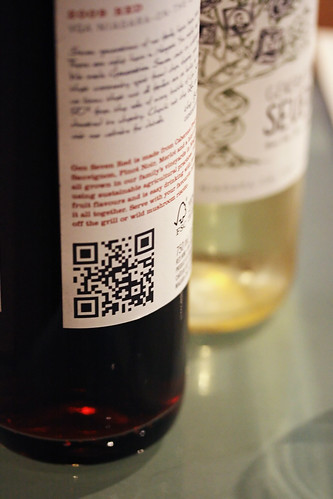 Even today, the Boscs are still embracing new technology, whether it's turning the labels of their Generation Seven wines into an interactive experience using high-tech QR codes, which launch a website describing their charitable partnership with Meal Exchange (who will receive $.50 from each bottle sold), or embracing social media like Twitter, which Michèle feels is a great way for the Boscs to reach out beyond the boundaries of the chateau to connect and build relationships with their customers. "I love to connect with people," she says. "It's why we do what we do."
Even today, the Boscs are still embracing new technology, whether it's turning the labels of their Generation Seven wines into an interactive experience using high-tech QR codes, which launch a website describing their charitable partnership with Meal Exchange (who will receive $.50 from each bottle sold), or embracing social media like Twitter, which Michèle feels is a great way for the Boscs to reach out beyond the boundaries of the chateau to connect and build relationships with their customers. "I love to connect with people," she says. "It's why we do what we do."
Château des Charmes currently produces a wide variety of wines, so there was no lack of options to pair up with each of the courses for this Progressive Dinner.
In the end, here are the suggestions that Michèle and I settled on:
Amuse Bouche Course: Grilled Shrimp, Mango & Guacamole Bites
Pair with: Brut Sparkling Wine Méthode Traditionnelle, V.Q.A.
These little tortilla scoops filled with a mixture of guacamole, grilled mango and garlic-cilantro marinated shrimp have a bit of pep, thanks to the jalapeno pepper in the guacamole.
As Michèle says, cilantro can present a challenge when it comes to finding a wine pairing. In this case, the Brut sparkling wine is a great choice because its palate-cleansing crispness cuts through the saltiness of the tortilla chips, while the pleasant effervescence revs up the taste buds and the fresh woody and grassy notes provide a nice complement to the cilantro.
Besides, considering this is the inaugural dinner in this series, how could we resist the urge to kick things off with a celebratory bottle of bubbly?
Appetizer Course: White Bean & Rosemary Bruschetta
Pair with: 2007 Sauvignon Blanc, St. David’s Bench Vineyard, V.Q.A. or 2008 Aligoté, Estate Bottled, V.Q.A
Since we weren't quite sure what the appetizer course would be when we met, Michèle suggested we choose a versatile white that would pair well with the two possible options of white bean bruschetta with rosemary or flatbread pizza with goat cheese.
Michèle explains that many wines, like this Sauvignon Blanc, take on very different characteristics depending on where they've been grown. This is a classic cool-climate Sauvignon Blanc, with a pale gold colour and hints of grass, citrus and gooseberries, as well as a slight mineral quality, which Michèle attributes to the source of artesian water for the vineyards around the château, which carries down limestone from the Niagara Escarpment, located at the back of the vineyard.
The Aligoté is a great alternative for those who aren't fans of Sauvignon Blanc. This slightly lesser-known variety is sometimes called "the other white grape of Burgundy", since Chardonnay is by far the better-known grape. The wine is unoaked and crisp with notes of grass and apple, and a smooth finish that the tasting notes describe as "butter".
Salad Course: Grilled and Stacked Ratatouille Salad
Pair with: Generation Seven White , V.Q.A. or 2008 Gamay Noir 'Droit', St. David’s Bench Vineyard, V.Q.A.
This elegant twist on the French standard combines all of the ingredients of a classic ratatouille with a fig balsamic marinade and crumbled goat cheese. These are all very strong flavours, as Michèle points out, which calls for a well-balanced wine to highlight both the sweetness of the balsamic and the acidity of the tomatoes.
This blend of Riesling, Sauvignon Blanc and Gewürztraminer grapes is named in honour of the seventh generation of winemakers in the Bosc family, represented by Michèle and Paul Jr.'s son Alex, and also in honour of the seventh generation sustainability practices that have been used in its preparation.
It's a fresh, fruity wine with hints of exotic fruit and honey, and with significantly more presence than the lighter whites we picked out for previous courses. It's just the right balance of sweetness and acidity that's needed to complement the bold flavours in the salad.
For those who insist on a red to pair with a tomato dish, the Gamay is a great alternative. Grown in the Bosc’s St. David's Bench Vineyard, this wine has the necessary balance of fruit flavours and acidity, along with earthy, red berry notes.
Entrée Course: A Manzo alla Panna (Beef Roast with a Parmigiano Reggiano and Cream Sauce)
Pair with: 2007 Equuleus, V.Q.A. or 2007 Pinot Noir, V.Q.A.; both hand-picked from the Paul Bosc Estate Vineyard located across the street from the château and the St. David’s Bench Vineyard.
In this dish, a rump roast is stuffed with shards of parmesan, then braised in red wine and cream until tender. To complement the softness of the braised beef and cream sauce, Michèle recommends choosing a soft, velvety wine so as not to overpower the subtle flavours.
Equuleus is named after the "Little Horse" constellation, because it's made from grapes grown in the vineyard block that surrounds stables on the Paul Bosc Estate and the Arabian horses that are Paul's second passion in life. This blend of Cabernet Sauvignon, Cabernet Franc and Merlot is full-bodied, with lots of tannin and hints of smoke, pepper and currant. It's substantial, but not overpowering.
The Pinot Noir, Michèle's current favourite among their reds, has a bright colour and is very smooth with notes of berry, pepper and plum. Which one you choose here is really a matter of preference, since both are eminently drinkable reds with complex flavours and a smooth finish.
Dessert Course: Pink Peppercorn Ice Cream
Pair with: 2007 Cabernet Franc Icewine Estate Bottled, V.Q.A.
You’d think that a peppery ice cream would be a tricky dish to pair up with a wine, but Michèle had this one well in hand.
This particular Icewine is an unusual true red, where the majority are made from white grapes. It's intensely ruby-red in colour, and reminiscent of Port with a velvety texture and notes of blackcurrant and berry jam. The balanced acidity is just right for the pink pepper in the ice cream, which was described as "floral and fruity with a hint of spice". For an extra-special touch, drizzle a little of the Icewine onto the ice cream before serving.
If you're planning a dinner of your own, Michèle also shared a few general wine pairing tips with us:
1. Try to plan your meal as a winemaker's style dinner (as we did here), by starting the meal with light, palate-cleansing whites and then working towards richer reds as the meal progresses.
2. When choosing a wine, consider the words you would use to describe the flavours in your dish, then look for a wine that you would describe using those same words. A light citrusy dish, for example, pairs best with a wine that has light, citrusy flavours.
3. When pairing a wine with dessert, make sure that both the wine and dessert have a similar level of sweetness. For example, the red Icewine paired perfectly with the pink peppercorn ice cream for this meal, but would have fallen flat if served with a bittersweet chocolate cake.
--
To find out more about the various wines produced at Château des Charmes, check out their website. The château is open to the public and offers regular tours of the winery, as well as an on-site wine boutique where you can find all of the wines for this dinner. The winery also hosts special events, including a Harvest Feast dinner at the château this Sunday, September 26th, featuring four Niagara chefs in an interactive, progressive dinner.
For all the recipes featured in this Progressive Dinner and to find out more about the Kitchen Play project, please visit the Kitchen Play website.
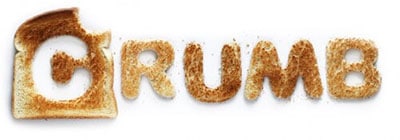


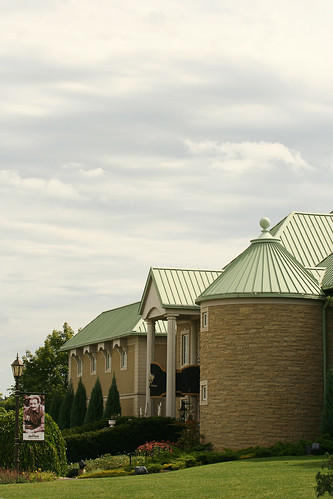
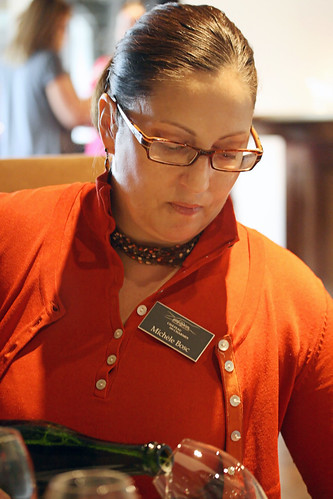
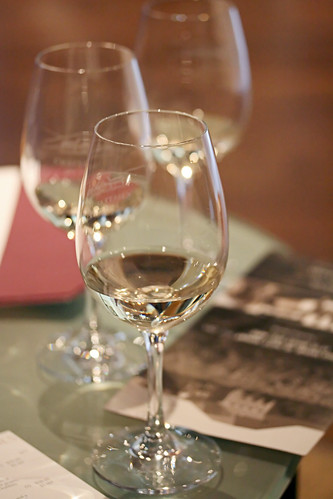

Michele Bosc says
HI RJ,
Our Cabernet Franc Icewine is not yet available in Florida but our Vidal Icewine is on the core wine list at Disney. So you can find it at many of the restaurants on property. Paul and I will be attending the EPCOT Food and Wine Festival in early Novemeber. If you are going please stop by to say hello.
RJ Flamingo says
Lovely! We're huge fans of icewines around here, and I'd love to get a taste of that Cabernet Franc! Must research to see if we can get it in Florida...